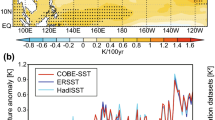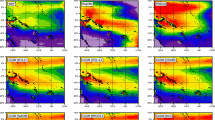Abstract
Future climate change in the western North Pacific at the end of the 21st century (2081–2100) was examined using a high-resolution regional ocean model (10-km mesh) under the RCP2.6 and RCP8.5 scenarios. The range of uncertainty in future projections was estimated from ensemble simulations. Projected results indicated no significant change in the Kuroshio net transport and the latitude of the Kuroshio Extension under both RCP scenarios; the changes were within the range of variability associated with the present climate. Projected sea surface temperature (SST) increased by as much as several degrees Celsius, especially in SST fronts, including the subarctic frontal zone. The significant increase of SST east of Japan was attributed to the northward expansion of the northern part of the subtropical gyre in response to basin-scale atmospheric changes. The projected area of sea ice in the Sea of Okhotsk decreased in both RCP scenarios. The projected offshore sea-level rise was larger in the subtropical gyre and smaller in the subpolar gyre. The sea-level rise along the coast of Japan, in contrast, showed no significant spatial variation. The mean sea-level rise along the coast of Japan was mostly comparable to the global mean sea-level rise.


















Similar content being viewed by others
Change history
07 February 2022
A Correction to this paper has been published: https://doi.org/10.1007/s10872-022-00635-8
References
Aoki K, Kutsuwada K (2008) Verification of the wind-driven transport in the North Pacific subtropical gyre using gridded wind-stress products. J Oceanogr 64:49–60
Austermann J, Mitrovica JX (2015) Calculating gravitationally self-consistent sea level changes driven by dynamic topography. Geophys J Int 203:1909–1922
Bryan K (1996) The steric component of sea level rise associated with enhanced greenhouse warming: a model study. Climate Dyn 12:545–555
Giese BS, Ray S (2011) El Niño variability in simple ocean data assimilation (SODA). J Geophys Res 116(C02):024
Greatbatch RJ (1994) A note on the representation of steric sea level in models that conserve volume rather than mass. J Geophys Res 99:12767–12771
Griffies SM, Greatbatch RJ (2012) Physical processes that impact the evolution of global mean sea level in ocean climate models. Ocean Model 51:37–72
Griffies SM, Hallberg RW (2000) Biharmonic friction with a Smagorinsky-like viscosity for use in large-scale eddy-permitting ocean models. Mon Weather Rev 128:2935–2946
Han W, Stammer D, Thompson P, Ezer T, Palanisamy H, Zhang X, Domingues CM, Zhang L, Yuan D (2019) Impacts of basin-scale climate modes on coastal sea level: a review. Surv Geophys 40:1493–1541. https://doi.org/10.1007/s10712-019-09562-8
Hirahara S, Ishii M, Fukuda Y (2014) Centennial-scale sea surface temperature analysis and its uncertainty. J Climate 27:57–75
Hsieh W, Bryan K (1996) Redistribution of sea level rise associated with enhanced greenhouse warming: a simple model study. Climate Dyn 12:535–544
Hunke EC, Dukowicz JK (1997) An elastic-viscous-plastic model for sea ice dynamics. J Phys Oceanogr 27:1849–1867
Ishizaki H, Yamanaka G (2010) Impact of explicit sun altitude in solar radiation on an ocean model simulation. Ocean Model 33:52–69. https://doi.org/10.1016/j.ocemod.2009.12.002
Isoda Y, Saitoh S, Mihara M (1991) SST structure of the polar front in the Japan Sea. Elsevier Oceanogr Ser 54:103–112
JMA (2015) Extreme weather report 2014 (in Japanese). https://www.data.jma.go.jp/cpdinfo/climate_change/
JMA (2020) Bulletin of climate monitoring 2019 (in Japanese). https://www.data.jma.go.jp/cpdinfo/monitor/
Kida S, Mitsudera H, Aoki S, Guo X, Ito S, Kobashi F, Kubokawa N, Miyama T, Morie R, Nakamura H, Nakamura T, Nakano H, Nishigaki H, Nonaka M, Sasaki H, Sasaki Y, Suga T, Sugimoto S, Taguchi B, Takaya K, Tozuka T, Tsujino H, Usui N (2015) Oceanic fronts and jets around Japan: a review. J Oceanogr 71:469–497
Kobayashi S, Ota Y, Harada Y, Ebita A, Moriyama M, Onoda H, Onogi K, Kamahori H, Kobayashi C, Endo H, Miyaoka K, Takahashi K (2015) The JRA-55 reanalysis: general specifications and basic characteristics. J Meteorol Soc Japan 93:5–48
Large WG, Yeager SG (2004) Diurnal to decadal global forcing for ocean and sea-ice models: the data sets and flux climatologies. NCAR technical note, NCAR/TN-460+STR CGD Division of the National Center for Atmospheric Research
Li R, Jing Z, Chen Z, Wu L (2017) Response of the Kuroshio extension path state to near-term global warming in CMIP5 experiments with MIROC4h. J Geophys Res 122:2871–2993
Liu ZJ, Minobe S, Sasaki Y, Terada M (2016) Dynamical downscaling of future sea level change in the western North Pacific using ROMS. J Oceanogr 72:905–922
Lorenzo ED, Schneider N, Cobb K, Franks P, Chhak K, Miller A, McWilliams J, Bograd S, Arango H, Curchitser E (2008) North Pacifc Gyre Oscillation links ocean climate and ecosystem change. Geophys Res Lett 35:L08607
Losch M, Adcroft A, Campin JM (2004) How sensitive are coarse general circulation models to fundamental approximations in the equations of motion? J Phys Oceanogr 34:306–319
Mantua NJ, Hare SR, Zhang Y, Wallace JM, Francis RC (1997) A Pacific interdecadal climate oscillation with impacts on salmon production. Bull Am Meteorol Soc 78:1069–1079
Mellor GL, Ezer T (1995) Sea level variations induced by heating and cooling: an evaluation of the Boussinesq approximation in ocean models. J Geophys Res 100:20565–20577
Mellor GL, Kantha L (1989) An ice-ocean coupled model. J Geophys Res 94:10937–10954
Mertz F, Pujol M, Faugere Y (2018) Product user mannual (cmems-sl-pum-008-032-051). cmems-resources.cls.fr version 4
Minobe S, Terada M, Qiu B, Schneider N (2017) Western boundary sea level: a theory, rule of thumb, and application to climate modes. J Phys Oceanogr 47:957–977
Mitrovica J, Tamisiea ME, Davis JL, Milne GA (2001) Recent mass balance of polar ice sheets inferred from patterns of global sea-level change. Nature 409:1026–1029
Mitrovica J, Gomez N, Morrow E, Hay C, Latychev K, Tamisiea ME (2011) On the robustness of predictions of sea level fingerprints. Geophys J Int 187:729–742
Monterey GI, Levitus S (1997) Climatological cycle of mixed layer depth in the world ocean. U S Gov Printing Office
Nakano H, Tsujino H, Sakamoto K, Urakawa S, Toyoda T, Yamanaka G (2018) Identification of the fronts from the Kuroshio Extension to the subarctic current using absolute dynamic topographies in satellite altimetry products. J Oceanogr 74:393–420
Nishikawa H, Nishikawa S, Ishizaki H, Wakamatsu T, Ishikawa Y (2020) Detection of the Oyashio and Kuroshio fronts under the projected climate change in the 21st century. Prog Earth Planet Sci 7:29. https://doi.org/10.1186/s40645-020-00342-2
Nishikawa S, Wakamatsu T, Ishizaki H, Sakamoto K, Tanaka Y, Tsujino H, Yamanaka G, Kamachi M, Ishikawa Y (2021) Development of high-resolution future ocean regional projection datasets for coastal applications in Japan. Prog Earth Planet Sci 8:7. https://doi.org/10.1186/s40645-020-00399-z
Noh Y, Kim HJ (1999) Simulations of temperature and turbulence structure of the oceanic boundary layer with the improved near-surface process. J Geophys Res 104:15621–15634
Peltier W (2004) Global glacial isostasy and the surface of the ice-age earth: the ICE-5G (VM2) model and GRACE. Annu Rev Earth Planet Sci 32:111–149
Portner HO, Roberts DC, Masson-Delmotte V, Zhai P, Tignor M, Poloczanska E, Mintenbeck K, Nicolai M, Okem A, Petzold J, Rama B, (eds) NW (2019) Summary for policymakers. In: IPCC special report on the ocean and cryosphere in a changing climate
Prather MJ (1986) Numerical advection by conservation of second-order moments. J Geophys Res 91:6671–6681
Qiu B, Chen S, Sasaki H (2013) Generation of the North Equatorial Undercurrent jets by triad baroclinic Rossby wave interactions. J Phys Oceanogr 43:2682–2698
Sakamoto T, Hasumi H, Ishii M, Emori S, Suzuki T, Nishimura T, Sumi A (2005) Responses of the Kuroshio and the Kuroshio Extension to global warming in a high-resolution climate model. Geophys Res Lett 32:L14617
Sasaki Y, Minobe S, Miura Y (2014) Decadal sea-level variability along the coast of Japan in response to ocean circulation changes. J Geophys Res 119:266–275
Sasaki Y, Washizu R, Yasuda T, Minobe S (2017) Sea level variability around Japan during the twentieth century simulated by a regional ocean model. J Climate 30:5585–5595
Sato Y, Yukimoto S, Tsujino H, Ishizaki H, Noda A (2006) Responses of the North Pacific ocean circulation in a Kuroshio-resolving ocean model to an Arctic Oscillation (AO)-like change in Northern Hemisphere atmospheric circulation due to greenhouse-gas forcing. J Meteorol Soc Japan 84:295–309
Stoacker TF, Qin D, Plattner GK, Tignor M, Allen SK, Boschung J, Nauels A, Xia Y, Bex V (eds) (2013) Climate change 2013: the physical science basis. Cambridge University Press, Cambridge
Sue Y, Kubokawa A (2015) Latitude of eastward jet prematurely separated from the western boundary in a two-layer quasigeostrophic model. J Phys Oceanogr 45:737–754
Suzuki T, Ishii M (2011) Long-term regional sea level changes due to variations in water mass density during the period 1981–2007. Geophys Res Lett 38(L21):604. https://doi.org/10.1029/2011Gl049326
Suzuki T, Tatebe H (2020) Future dynamic sea level change in the western subtropical North Pacific associated with ocean heat uptake and heat redistribution by ocean circulation under global warming. Prog Earth Planet Sci. https://doi.org/10.1186/s40645-020-00381-9
Taylor KE, Stouffer RJ, Meehl GA (2012) An overview of CMIP5 and the experiment design. Bull Am Meteorol Soc 93:485–498. https://doi.org/10.1175/BAMS-D-11-00094.1
Terada M, Minobe S (2018) Projected sea level rise, gyre circulation and water mass formation in the western North Pacific: CMIP5 inter-model analysis. Climate Dyn 50:4767–4782. https://doi.org/10.1007/s00382-017-3902-8
Toda M, Watanabe M (2020) Mechanisms of enhanced ocean surface warming in the Kuroshio region for 1951–2010. Climate Dyn 54:4129–4145. https://doi.org/10.1007/s00382-020-05221-6
Tsujino H, Nakano H, Motoi T (2008) Mechanism of currents through the straits of the Japan Sea: mean state and seasonal variation. J Oceanogr 64:141–161
Tsujino H, Nakano H, Sakamoto K, Urakawa S, Hirabara M, Ishizaki H, Yamanaka G (2017) Reference manual for the Meteorological Research Institute Community Ocean Model version 4 (MRI.COMv4). Technical Reports of the Meteorological Research Institute, p 80. https://doi.org/10.11483/mritechrepo.80
Wada Y, van Beek L, Weiland F, Chao B, Wu YH, Bierkess M (2012) Past and future contribution of global groundwater depletion to sea-level rise. Geophys Res Lett 39(L09):402
Wakamatsu S, Oshio K, Ishihara K, Murai H, Nakashima T, Inoue T (2017) Estimating regional climate change uncertainty in Japan at the end of the 21st century with mixture distribution. Hydrol Res Lett 11:65–71
Wang J, Li C (2017) Low-frequency variability and possible changes in the North Pacific simulated by CMIP5 models. J Meteorol Soc Japan 95:199–211
Wu L, Cai W, Zhang L, Nakamura H, Timmermann A, Joyce T, McPhaden MJ, Alexander M, Qiu B, Visbeck M, Chang P, Giese B (2012) Enhanced warming over the global subtropical western boundary currents. Nat Climate Change 2:161–166
Yamaguchi K, Noda A (2006) Global warming patterns over the North Pacific: ENSO versus AO. J Meteorol Soc Japan 84:221–241
Yasuda T, Sakurai K (2006) Interdecadal variability of the sea surface height around Japan. Geophys Res Lett 33:L01605
Yim BY, Kwon M, Min HS, Kug JS (2015) Pacific decadal oscillation and its relation to the extratropical atmospheric variation in CMIP5. Climate Dyn 44:1521–1540
Yin J, Griffies SM, Stouffer RJ (2010) Spatial variability of sea level rise in twenty-first century projections. J Climate 23:4585–4607
Zhang Y, Wallace JM, Battisti DS (1997) ENSO-like interdecadal variability: 1900–93. J Climate 10:1004–1020
Acknowledgements
The authors would like to thank many individuals at the atmospheric environment and ocean division of Japan Meteorological Agency for their sustained efforts of ocean observations and analysis of ocean data. Constructive comments made by the two anonymous reviewers were helpful for improving the manuscript. This work was funded by the Meteorological Research Institute. Partial support by MEXT Grant-in-Aid for Scientific Research (TOUGOU: Grant No. JPMXD0717935561 and SICAT: Grant No. JPMXD0715667163) was greatly acknowledged. TW was supported by the Nansen Center (NERSC) basic funding.
Author information
Authors and Affiliations
Corresponding author
Rights and permissions
About this article
Cite this article
Yamanaka, G., Nakano, H., Sakamoto, K. et al. Projected climate change in the western North Pacific at the end of the 21st century from ensemble simulations with a high-resolution regional ocean model. J Oceanogr 77, 539–560 (2021). https://doi.org/10.1007/s10872-021-00593-7
Received:
Revised:
Accepted:
Published:
Issue Date:
DOI: https://doi.org/10.1007/s10872-021-00593-7




